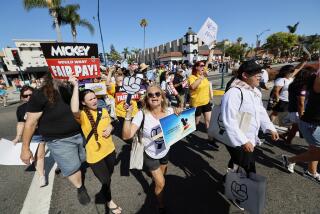City Gives Final Approval to Plans for Disney Resort
ANAHEIM â The City Council on Tuesday gave final approval to the zoning and planning documents for the proposed $3-billion Disneyland Resort, clearing the way for development of the ambitious project.
The 4-0 vote, with one councilman absent, means the Walt Disney Co. could begin construction immediately. But company officials say they will not commit to the project unless public agencies agree to provide about $800 million of the development costs.
Disney and city officials are still negotiating a development agreement, which would spell out who would finance what, and when different aspects of the resort would be built.
Tuesday nightâs action by the council completed a two-step approval process that began last week with certification of the environmental impact report on the project. The zoning and planning documents, which included several new city ordinances, were introduced last week and required a second vote Tuesday.
âIt was the addendum to a milestone vote,â said Disney Development Co. Vice President Kerry Hunnewell after the action. âWeâve still got the financial hurdles to get over, but weâre cautiously optimistic.â
Anaheim Mayor Tom Daly praised the cityâs review process, which took two years to complete, calling it âstate-of-the-art planning . . . that will hopefully result in a project that will be world-renowned.â
As approved by the council, the proposed resort includes a new theme park to be built next to Disneyland, a 5,000-seat amphitheater, a shopping district, hotels in and outside the park and two of the countryâs largest parking garages.
The new amusement park, called Westcot, would have an international theme, and visitors would voyage through miniature versions of the Americas, Europe, Africa and Asia. The park would also have a vision of the future that would explore âthe wonders of science and nature.â The complex would be built around a giant spire, which would be the parkâs hallmark.
The goal is to transform Disneyâs well-trod Magic Kingdom into a destination resort where millions of tourists would eat, shop, sleep and play.
City officials say the project would help overhaul the cityâs deteriorating public infrastructure and revitalize a part of the city that has been overrun by undistinguished motels, tourist shops and restaurants.
While Disney would bear the full cost of the $2.2-billion theme park, hotels and other tourist centered-amenities, it has asked public agencies to pay for the balance, including street and freeway improvements, and the 30,000-vehicle parking garages. So far, federal, state and county agencies have talked about paying between $191 million and $228 million of the costs of these public works.
The project is expected to create tens of thousands of jobs and generate about $2.4 billion in economic activity annually statewide, according to Disneyâs estimates. City officials, in their own economic review, say the project would add about $27 million to city coffers when the park opens in 1998.
The city could end up financing $500 million to $600 million of the public costs, with much of that coming from the sale of municipal bonds, and the possible creation of several assessment districts.
Opponents of the proposed resort said Tuesday that the city has ignored their interests in the pursuit of the Disney Co. They said the council should not accept the project as proposed, contending the 490-acre development will worsen traffic, pollute the air, create noise and adversely impact the lives of nearby residents and business owners.
âOnce again the mayor and our city leaders have chosen to sell out the neighborhoods in favor of a pie-in-the-sky development,â said Steve White, president of a homeownerâs group opposed to the proposed resort, after the vote. âThis was no surprise. It was a slam dunk.â
Although city officials acknowledge that the project would cause seven short- and long-term impacts, they say the economic and social benefits of the project outweigh the disadvantages. Furthermore, they say, Disney has incorporated more than 160 design features to lessen or eliminate most of the problems.
With the action taken Tuesday, the council adopted as ordinances changes to the zoning and height limitations throughout the properties around Disneyland, known as the Commercial Recreation Area.
The ordinances restrict the density and heights for developments around the park, effectively forcing projects around the resort to be smaller and shorter than previous standards.
The most vocal critics of the project have been the city of Garden Grove, several local school districts and Whiteâs group called Anaheim HOME. All of these have said they will continue to oppose the proposal, with Anaheim HOME saying it would seek a referendum on the project.
In addition, one group of local business owners said last week they will sue the city over the environmental review of the project, claiming that the adverse impacts were not fully considered. Others are considering similar legal action.
The threat of lawsuits is a concern for both the city and Disney, and it caused a snag between the two last week. The city wanted Disney to pay potential court costs, including damages in the event of a successful suit. Disney had agreed to pay most court costs, including lawyersâ fees, but balked at paying any potential damages.
Attorneys reached a compromise late Monday evening when the Disney Co. agreed to reimburse any court-ordered damages out of future revenue from the project. If the project isnât built, Disney would still be liable for those expenses, city officials said.
Officials from the state have taken an interest in the project and shared the concern about potential litigation. Recently, the stateâs education secretary had stepped into the conflict between the several local school districts and Disney and Anaheim to try and mediate a resolution.
âIâm really just a facilitator, a cog between their two gears,â said Maureen DiMarco, the stateâs secretary for child development and education.
DiMarco said Tuesday that the negotiations appeared to be productive, but that there has been no bottom-line talk on what might be done to offset the costs the districts contend they would incur because of the project.
WHATâS NEXT
Disney and city officials will be monitoring Orange County Superior Court to see if opponents of Disneyland Resort file suit challenging the cityâs approval of the project. The deadline for lawsuits on the environmental impact report is July 23. The deadline for challenging the zoning and planning documents is July 29. This summer, the city and Disney will continue negotiating a development agreement that would detail how the city will finance a portion of public infrastructure costs and set construction timetables for Disney. That agreement, which must be approved by the City Council, is expected to be concluded by fall.
More to Read
Sign up for Essential California
The most important California stories and recommendations in your inbox every morning.
You may occasionally receive promotional content from the Los Angeles Times.










